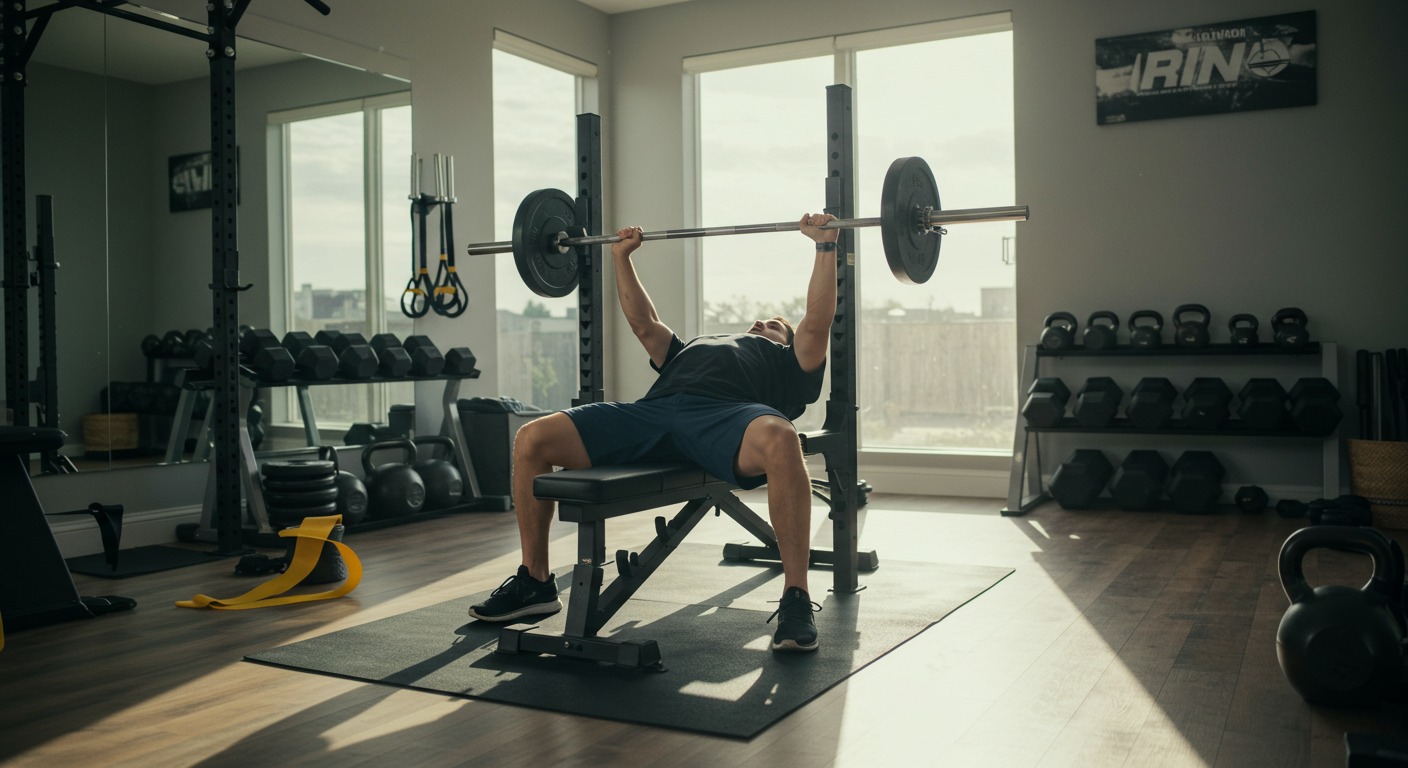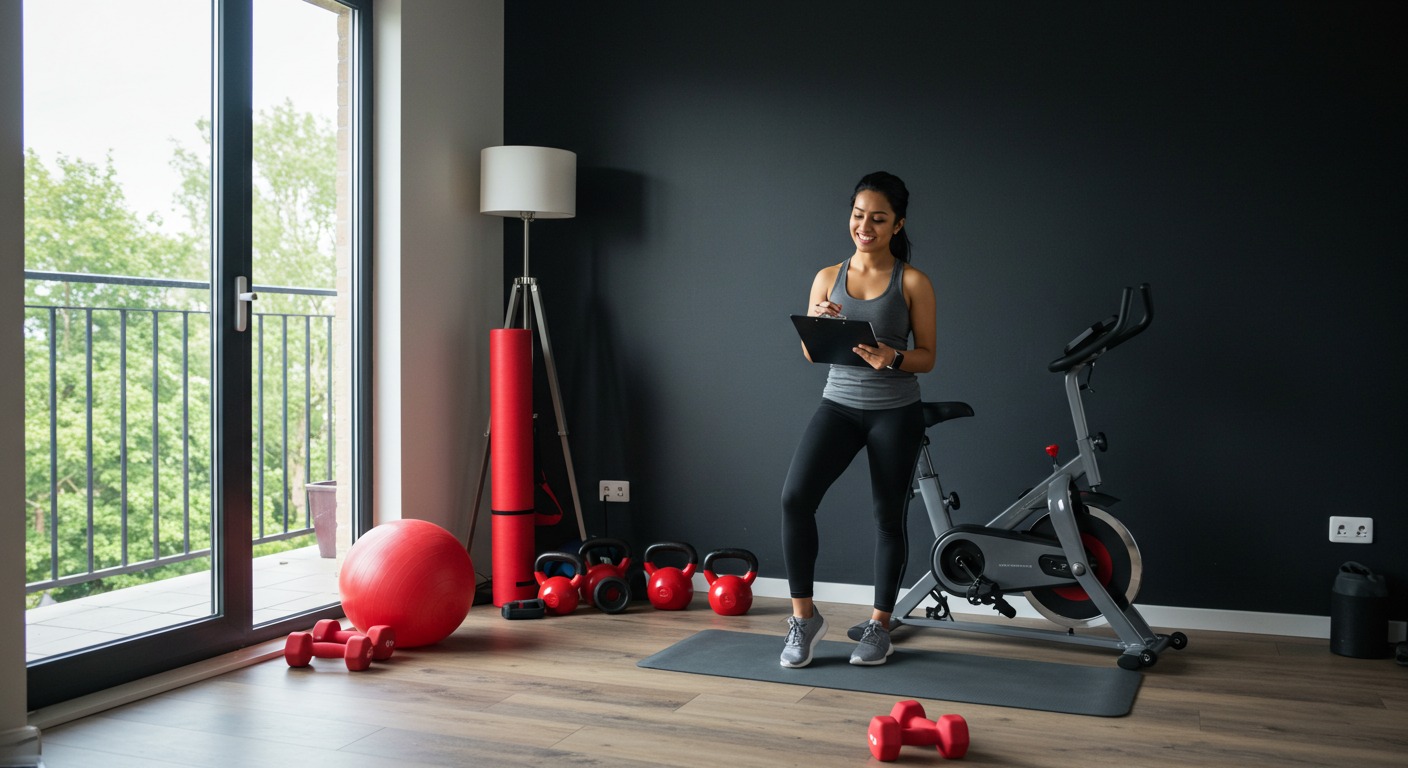Disclosure Information
This blog contains affiliate links. If you make a purchase through one of these links, our team may earn a commission at no extra cost to you. Learn more. Thanks for your support!
Starting your strength training journey doesn’t require expensive gym memberships or fancy equipment. Your home can become the perfect training ground for building muscle, increasing strength, and improving overall fitness.
Home strength training offers unmatched convenience and privacy. You can work out whenever you want, wear whatever feels comfortable, and progress at your own pace without feeling intimidated by experienced lifters.
Why Choose Home Strength Training
Home workouts eliminate common barriers that prevent people from exercising regularly. No more commuting to the gym, waiting for equipment, or dealing with crowded facilities during peak hours.
You’ll save money on gym memberships and gas. The average gym membership costs $58 per month, totaling nearly $700 annually (source: Berkley). Home training requires minimal upfront investment with long-term savings.
Privacy becomes your greatest advantage. Many beginners feel self-conscious about their form or fitness level. Training at home removes these psychological barriers and allows you to focus solely on your workout.
Flexibility in scheduling makes consistency easier. You can exercise early morning, during lunch breaks, or late evening without worrying about gym hours or availability.
Essential Equipment for Home Strength Training
Starting with basic equipment keeps costs manageable while providing excellent training opportunities. You don’t need a full gym setup to achieve impressive results.
Bodyweight Training Basics
Your body provides the most accessible resistance tool. Bodyweight exercises require zero equipment and can be performed anywhere in your home with adequate floor space.
Push-ups target chest, shoulders, and triceps effectively. Squats work your entire lower body while improving functional movement patterns. Planks strengthen your core and improve stability.
Pull-ups present the main challenge for bodyweight training. A doorway pull-up bar costs under $30 and opens numerous upper body exercise possibilities.
Affordable Equipment Options
| Equipment | Price Range | Primary Benefits |
|---|---|---|
| Resistance Bands | $10-30 | Portable, versatile |
| Dumbbells | $50-200 | Progressive overload |
| Kettlebells | $40-80 | Full-body training |
Resistance bands offer incredible versatility for strength training. They provide variable resistance that challenges muscles throughout the entire range of motion. Bands take up minimal storage space and cost significantly less than traditional weights.
Adjustable dumbbells represent excellent value for money. They replace multiple fixed-weight dumbbells and allow for progressive overload as you get stronger. Quality sets range from $100-400 depending on weight capacity.
Kettlebells excel at combining strength and cardiovascular training. A single kettlebell provides dozens of exercise options targeting every muscle group. Start with a moderate weight (15-25 pounds for women, 25-35 pounds for men).
Setting Up Your Home Gym Space
Creating an effective workout space requires minimal square footage. A 6×8 foot area provides sufficient room for most strength training exercises and equipment storage.
Choose a location with adequate ceiling height for overhead movements. Basements, spare bedrooms, or even living rooms can work well. Ensure proper ventilation to maintain comfortable temperatures during workouts.
Invest in quality flooring to protect your floors and provide stability. Interlocking foam tiles or rubber mats prevent equipment damage and reduce noise for neighbors or family members.
Storage solutions keep your space organized and safe. Wall-mounted racks, storage bins, or dedicated shelving prevent equipment from becoming hazards when not in use.
Understanding Strength Training Fundamentals
Strength training involves applying resistance to muscles, forcing them to adapt and grow stronger. This process requires progressive overload, proper form, and adequate recovery time.
Progressive overload means gradually increasing training demands over time. This happens through adding weight, increasing repetitions, or improving exercise difficulty. Without progression, your body adapts and stops improving.
Proper form ensures safety and maximizes training effectiveness. Poor technique increases injury risk and reduces muscle activation. Always prioritize correct movement patterns over heavy weights.
Recovery allows muscles to repair and grow stronger. Muscles don’t grow during workouts; they grow during rest periods. Adequate sleep, nutrition, and rest days are essential for progress.
Basic Movement Patterns for Beginners
All strength training exercises fall into fundamental movement patterns. Mastering these patterns provides the foundation for more advanced exercises and prevents injuries.
Upper Body Movements
Push Movements target chest, shoulders, and triceps. Push-ups, overhead presses, and chest presses represent primary pushing exercises. Start with wall push-ups if floor push-ups are too challenging.
Pull Movements work back muscles, rear deltoids, and biceps. Rows, pull-ups, and lat pulldowns fall into this category. Resistance band rows offer an excellent starting point for beginners.
Isolation Movements target specific muscle groups. Bicep curls, tricep extensions, and lateral raises provide focused muscle development. These exercises complement compound movements but shouldn’t replace them.
Lower Body Movements
Squatting engages quadriceps, glutes, and core muscles. Bodyweight squats, goblet squats, and wall sits all utilize this movement pattern. Focus on sitting back into your heels and maintaining upright posture.
Hip Hinge Movements emphasize posterior chain muscles including glutes and hamstrings. Deadlifts, Romanian deadlifts, and hip thrusts represent this pattern. These exercises improve posture and reduce lower back pain.
Single-Leg Movements challenge balance while building unilateral strength. Lunges, step-ups, and single-leg deadlifts prevent muscle imbalances and improve functional movement quality.
Creating Your First Workout Routine
Effective beginner routines focus on full-body workouts performed 2-3 times per week. This frequency allows adequate recovery while providing sufficient training stimulus for adaptation.
Sample Beginner Routine
Day 1: Full Body Foundation
- Bodyweight squats: 3 sets of 8-12 reps
- Push-ups (modified if needed): 3 sets of 5-10 reps
- Resistance band rows: 3 sets of 10-15 reps
- Plank: 3 sets of 15-30 seconds
- Glute bridges: 3 sets of 12-15 reps
Day 2: Rest or Light Activity Take complete rest or engage in light walking, stretching, or yoga. Active recovery promotes blood flow and reduces muscle stiffness.
Day 3: Full Body Progression
- Goblet squats: 3 sets of 8-12 reps
- Incline push-ups: 3 sets of 8-12 reps
- Single-arm dumbbell rows: 3 sets of 8-10 per arm
- Side planks: 2 sets of 10-20 seconds per side
- Deadlifts (light weight): 3 sets of 8-10 reps
Day 4: Rest
Day 5: Full Body Challenge
- Jump squats: 3 sets of 5-8 reps
- Standard push-ups: 3 sets of 8-12 reps
- Resistance band face pulls: 3 sets of 12-15 reps
- Mountain climbers: 3 sets of 10-15 per leg
- Romanian deadlifts: 3 sets of 10-12 reps
Proper Form and Technique
Correct form prevents injuries and ensures optimal muscle activation. Poor technique limits progress and increases risk of muscle strains or joint problems.
Key Form Principles
Maintain neutral spine alignment throughout all exercises. Avoid excessive arching or rounding of the back. Engage core muscles to support spinal stability.
Control the movement tempo rather than rushing through repetitions. Slow, controlled movements provide better muscle stimulation and reduce injury risk. Aim for 2-3 seconds during both lifting and lowering phases.
Breathe properly to maintain oxygen flow and core stability. Generally, exhale during the exertion phase and inhale during the lowering phase. Never hold your breath during heavy lifting.
Use full range of motion when possible. Complete movements through their entire range provide better flexibility and muscle development. Partial movements have specific applications but shouldn’t dominate your routine.
Progressive Overload Strategies
Progression drives continuous improvement in strength training. Without increasing training demands, your body adapts and stops responding to your workouts.
Progression Methods
Increase Repetitions within your target range before adding weight. If you can complete 12 reps easily, increase to 13-15 reps before progressing to heavier resistance.
Add Weight Gradually using small increments. For dumbbells, increase by 2.5-5 pounds per exercise. For bodyweight exercises, add resistance bands or weighted vests.
Improve Exercise Difficulty by progressing to more challenging variations. Wall push-ups progress to incline push-ups, then standard push-ups, and eventually decline push-ups.
Reduce Rest Time between sets to increase training density. Start with 60-90 seconds of rest and gradually decrease to 45-60 seconds as conditioning improves.
Nutrition for Strength Training
Proper nutrition supports muscle recovery, growth, and performance. Your diet provides the raw materials your body needs to adapt to training stress.
Research shows that individuals following structured nutrition plans see 25% greater strength gains compared to those without dietary guidance (source: Journal of Sports Medicine). Nutrition timing and quality significantly impact training results.
Protein Requirements
Protein provides amino acids necessary for muscle protein synthesis. Aim for 0.8-1.2 grams of protein per pound of body weight daily. Higher protein intake supports muscle growth and recovery.
Quality protein sources include lean meats, fish, eggs, dairy products, legumes, and protein powders. Distribute protein intake throughout the day for optimal muscle protein synthesis.
Carbohydrate Timing
Carbohydrates fuel intense training sessions and support recovery. Consume complex carbohydrates 1-2 hours before workouts for sustained energy. Simple carbohydrates work well immediately post-workout for glycogen replenishment.
Hydration Importance
Proper hydration affects strength, endurance, and recovery. Dehydration of just 2% can reduce performance by 10-15%. Drink water throughout the day and increase intake during training sessions.
Recovery and Rest
Recovery represents the time when your body actually gets stronger. Training provides the stimulus, but adaptation occurs during rest periods between sessions.
Sleep quality significantly impacts strength training results. Adults need 7-9 hours of quality sleep for optimal recovery and hormone production. Poor sleep reduces testosterone and growth hormone levels.
Active Recovery
Light movement on rest days promotes blood flow and reduces muscle stiffness. Walking, gentle stretching, or yoga help maintain mobility without interfering with recovery.
Stress Management
Chronic stress elevates cortisol levels, which can impair muscle growth and recovery. Incorporate stress-reduction techniques like meditation, deep breathing, or relaxing hobbies into your routine.
Common Beginner Mistakes
Avoiding common pitfalls accelerates progress and reduces injury risk. Learning from others’ mistakes saves time and prevents frustration.
Training Too Frequently
Enthusiasm often leads beginners to train daily without adequate recovery. Muscles need 48-72 hours of rest between intense sessions targeting the same muscle groups.
Ignoring Form for Weight
Lifting heavy weights with poor form increases injury risk and reduces training effectiveness. Master bodyweight movements before adding external resistance.
Inconsistent Training
Sporadic training prevents adaptation and progress. Consistency trumps intensity for long-term success. Three quality workouts per week beat seven inconsistent sessions.
Inadequate Warm-up
Jumping into intense exercise without proper warm-up increases injury risk. Spend 5-10 minutes performing light cardio and dynamic stretching before strength training.
Tracking Progress
Monitoring progress maintains motivation and guides training adjustments. Various methods help track improvements beyond just weight changes.
Measurement Methods
Strength Improvements can be tracked through increased repetitions, heavier weights, or advanced exercise variations. Keep a training log to monitor these changes over time.
Body Composition Changes often occur before weight changes. Take body measurements, progress photos, and note how clothes fit. Muscle gain can offset fat loss on the scale.
Performance Metrics include improved energy levels, better sleep quality, and enhanced daily function. These quality-of-life improvements often motivate continued training.
Studies indicate that individuals who track their workouts are 42% more likely to achieve their fitness goals (source: Harvard Health Publishing). Consistent monitoring provides accountability and objective feedback.
Staying Motivated
Maintaining motivation through plateaus and busy periods determines long-term success. Developing strategies for consistency helps overcome inevitable challenges.
Goal Setting
Set specific, measurable, achievable, relevant, and time-bound (SMART) goals. Instead of “get stronger,” aim for “perform 10 consecutive push-ups within 8 weeks.”
Variety and Progression
Regularly introduce new exercises or variations to prevent boredom. Progressive challenges maintain engagement and continue stimulating adaptation.
Community Support
Join online fitness communities, find workout partners, or share progress with friends and family. Social support increases adherence and provides encouragement during difficult periods.
When to Seek Professional Help
Certain situations warrant professional guidance from qualified trainers or healthcare providers. Recognizing these scenarios prevents injuries and accelerates progress.
Medical Considerations
Consult healthcare providers before starting strength training if you have chronic conditions, previous injuries, or take medications that might affect exercise capacity.
Form Correction
If you cannot maintain proper form despite practice, consider hiring a qualified trainer for form assessment and correction. Poor movement patterns can lead to injuries.
Plateau Breaking
Persistent plateaus lasting 4-6 weeks may require program modifications. Experienced trainers can identify weaknesses and suggest appropriate progressions.
Building Long-term Success
Sustainable strength training requires patience, consistency, and realistic expectations. Focus on developing habits rather than pursuing quick fixes.
Transform your approach from short-term goals to lifestyle changes. Successful home strength training becomes part of your daily routine, not a temporary intervention.
Start small and build gradually. Consistency with simple routines produces better results than sporadic intense sessions. Small daily improvements compound into significant long-term changes.
Remember that strength training is a lifelong journey. Celebrate small victories, learn from setbacks, and maintain perspective on your long-term health and fitness goals.


